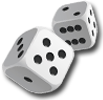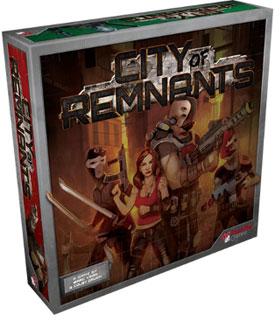



play board games
Board game reviews, strategy tips & session reports
City of Remnants Board Game Review
 Stats:
Stats:
No. of players: 2-4
Amount of time to play: 90-120 min
Age requirements: 13+
Set-up time: 5-10 minutes
City of Remnants puts you in charge of a refugee alien gang. You must compete for renown to become the most powerful gang in town. But look out for the cops, as they are out to stop everyone.
City of Remnants Rules Description:
You start this game by selecting one of the four gangs. Each gang has its own unique ten card starting deck. You shuffle then draw four cards to start the game. You also begin with 2,000 arcs which are the currency on this planet.
Each round you have four actions you can perform. Once you take an action the player to left may take one. You have six actions you can take. You may recruit, buy, produce/develop, sell, move or refresh your hand.
Recruit lets you add new members to your gang. You choose a card you’d like to add then it is up for auction. If you don’t win it you can choose another card until you do win. If other players win an auction on your turn it costs them one of their actions.
With a buy action you may purchase something from the black market. Some of these cards go into your deck while others are placed in front of you for a permanent effect. They are each worth one renown at the end of the game. You can also buy a renown for 3,000 arcs.
Produce is the first part of this action. It lets you place goods on any buildings you currently control by having gang members there. Develop allows you to add buildings to the maps. Building placement is restricted by different zones and they grant the person who controls them certain benefits and renown.
You can sell any goods you previously produced. The selling price depends on the type of production building(s) you have.
You can move gang members up to three spaces orthogonally on the map. If they occupy the same square as a rival gang combat ensues. You may never have more than two gang members on a space.
Refreshing your hand allows you to discard cards and draw back up to your hand size.
Combat uses both dice and cards. The attacker determines if he wants to designate cards to the fight. He may take cards from his hand or from the top of his deck. Gang members will add to your attack value and once the attacker decides how any cads they wish to play the defender does the same. Different gang members fight at different power for different gangs. Next you roll dice numbered from 0 through 3. You roll as many dice as you have gang members on the contested space plus one for each figure orthogonally adjacent to it. The total of your dice roll plus gang member strength is your final attack value. The attacker’s total must beat the defender’s total to win. The loser of the battle must remove one figure from the space. They must also remove a gang member card they played from the game. If they did not play a gang member card, they must remove one gang member from their discard. If there is not one there they must take one from their draw deck. Combat continues until the space is no longer contested.
You may also play any cards in your hand for their power. Some powers only take place in battle but others decrease the costs of item or developments and all are helpful in some way.
After each player uses up their four actions, the Yugai attack. Yugai are the robotic police that appear on random spaces on the board. You determine where they appear by drawing a card. They are represented by tokens you pull from a bag and have a combat value ranging from 5 to 1. If you don’t want to fight them you can bribe them to leave. Combat with Yugai is the same as it is with other players except that you only need to meet the attack value. Once you kill a Yugai you roll to determine the effects of that combat. Some effects are good and get you more renown or money but some spawn more Yugai or take your money.
At the end of each round you gain renown. You get renown from the developments you control as well as a few spaces on the board. If you run out of renown you keep your tally on paper and the game ends that round.
One last thing to mention is influence. You start with four influence and it determines your hand-size, how many gang members you can move and how any goods you can sell per action and how much renown you can buy each action. You gain influence by hitting different milestones throughout the game.
The winner is the player with the most renown from his renown tokens, and black market cards.
Quick Review of City of Remnants
This game combines several common board game mechanics to create a fun and unique experience. You’d think that with all the different things going on this would be a hot mess. But it isn’t, it plays intuitively and all fits within the theme.
The components for this game are very good. Everything from the minis to the cards is high quality. The box cover art is not the best but I like the art on the tiles and cards. The rules are a pretty easy read and the player boards have a ton of useful information.
I like how smart this game is designed. There are multiple paths to victory and everything you do fits together nicely. You control a bunch of developments on the board, fight your opponents or just make an economic engine to power your win.
i also like that the faction decks are different but don’t totally shoehorn you into a strategy. They will probably influence your strategy but they don’t hardcode it. They also seem pretty balanced and you might find value in stealing some powerful gang members from another faction just so they don’t get them.
Another thing to like about City of Remnants is how everything ramps up. You start small but soon are making more money and adding more gang members. It just feels like things get bigger as the game progresses. This is also very evident as your influence grows.
The game is not perfect however and some people might not like a few aspects of it. First some things can be pretty random. Specifically the Yugai patrols. They can be pretty tough early in the game. And even winning against them can land you with some bad results. If only one player gets beat up a few turns early in the game it can be hard for them to catch back up.
Even still, City of Remnants is a really smart, fun game that blends a lot of fun mechanics into an immersive experience. If you don’t mind the randomness of the dice or Yugai drop ins you should try it out. Or just pick it up.
Score and synopsis: (Click here for an explanation of these review categories.)
Strategy 4 out of 6
Luck 5 out of 6
Player Interaction 4 out of 6
Replay Value 4 out of 6
Complexity 4 out of 6
Fun 5 out of 6
Overall 5 out of 6

Leave a Reply